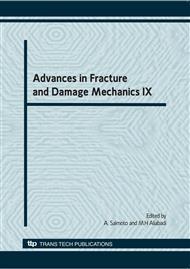p.245
p.249
p.253
p.257
p.261
p.265
p.269
p.273
p.277
Molding Conditions and Mechanical Properties of Jute Fiber Reinforced Composite
Abstract:
In this study, molding condition and tensile properties of jute fiber reinforced composite were examined. PVA resin was used as matrix which is one of the biodegradable resin. Before tensile test, specimens have an offset twist. The tensile test after twist of jute fiber cloth was also conducted. As a result, following results were obtained. In the case of jute fiber cloth, the effect of twist deformation to tensile strength is not great. The reason is thought that the fiber cloth is flexible and easy to deform in this form. In the case of composite, molding time has an effect to the tensile properties. As the molding temperature increases, the tensile strength increases. So, the diffraction intensity was measured. The reason of effect to the strength is thought that the crystallization occurred in the matrix. When the molding temperature is so high, fiber has degradation, and the strength of the composite decreases. As the degree of twist increases, the strength decreases. The reasons are the delamination between layers and debonding between fiber and matrix.
Info:
Periodical:
Pages:
261-264
Citation:
Online since:
November 2010
Authors:
Price:
Сopyright:
© 2011 Trans Tech Publications Ltd. All Rights Reserved
Share:
Citation:


